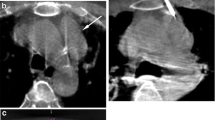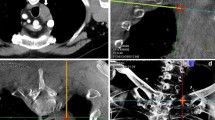Abstract
Introduction
The aim of this study is to report our early clinical experience using C-arm cone beam computed tomography with fluoroscopic overlay for image guidance during percutaneous needle procedures of the spine and pelvis.
Methods
Twelve consecutive patients (four female and eight male patients; mean age, 64 years; range, 47–74 years; SD ± 7.6 years) who underwent percutaneous biopsy of the spine and pelvis for suspected metastasis (n = 12), spondylodiscitis (n = 6), abscess (n = 5) or bone tumour (n = 1) were prospectively included between March 2009 and November 2010. The procedures were performed on the Allura Xper FD20/20 (Philips, Best, the Netherlands) using cone beam computed tomography (XperCT) with the C-arm combined with fluoroscopic overlay for needle guidance. Based on an initial XperCT, entry and target points were defined using dedicated guidance software (XperGuide). The needle path was visualised in various reconstructed planes and could be adjusted when considered necessary. For percutaneous interventions, the entry view (overlay of entry and target point in the bull's eye fashion), the progression view (perpendicular to the entry view) as well as two additional views could automatically be piloted to with the C-arm system. Needle navigation was supported by a biopsy guidance device (Seestar, Radi, Uppsala, Sweden). Correct needle positioning was confirmed with a second XperCT acquisition. Technical success was defined as any target point reached via the planned needle trajectory with a distance of final needle tip within 5 mm of the planned target point in any direction.
Results
In all 12 patients, target areas could be defined based on XperCT data. In 11 of 12 (92%) cases, the target point was successfully reached on the planned trajectory with a mean error of 2.8 mm (range, 0.5–9.4 mm; SD, 2.4 mm). No peri- or post-interventional complications occurred.
Conclusion
XperCT-guided interventions with the XperGuide system seem a safe and reliable tool for percutaneous needle interventions of the spine and pelvis. The advantage of the technique when compared to CT- or fluoroscopy-guided interventions needs to be determined in a comparative study of a larger scale.







Similar content being viewed by others
References
Nourbakhsh A, Grady JJ, Garges KJ (2008) Percutaneous spine biopsy: a meta-analysis. J Bone Joint Surg Am 90:1722–1725
Garcia JA, Bhakta S, Kay J et al (2009) On-line multi-slice computed tomography interactive overlay with conventional x-ray: a new and advanced imaging fusion concept. Int J Cardiol 133:101–105
Maeda N, Osuga K, Higashihara H et al (2008) A novel cone-beam CT guided interventions by XperGuide: accuracy and feasibility in a phantom model [abstract no. 237]. J Vasc Interv Radiol 19:90
Tam AL, Mohamed A, Pfister M, Chinndurai P, Rohm E, Hall AF, Wallace MJ (2010) C-arm cone beam computed tomography needle path overlay for fluoroscopic guided vertebroplasty. Spine 35:1095–1099
Söderman M, Babic D, Holmin S, Andersson T (2008) Brain imaging with a flat detector C-arm: technique and clinical interest of XperCT. Neuroradiology 50:863–868
Daly MJ, Siewerdsen JH, Moseley DJ, Jaffray DA, Irish JC (2006) Intraoperative cone-beam CT for guidance of head and neck surgery: assessment of dose and image quality using a C-arm prototype. Med Phys 33:3767–3780
Racadio JM, Babic D, Homan R et al (2007) Live 3D guidance in the interventional radiology suite. AJR Am J Roentgenol 189:357–364
Braak SJ, van Strijen MJ, van Leersum M, van Es HW, van Heesewijk JP (2010) Real-time 3D fluoroscopy guidance during needle interventions: technique, accuracy, and feasibility. AJR Am J Roentgenol 194:445–451
Roberts CC, Morrison WB, Deely DM, Zoga AC, Koulouris G, Winalski CS (2007) Use of a novel percutaneous biopsy localization device: initial musculoskeletal experience. Skeletal Radiol 36:53–57
Rimondi E, Staals EL, Errani C, Bianchi G, Casadei R, Alberghini M, Malaguti MC, Rossi G, Durante S, Mercuri M (2008) Percutaneous CT-guided biopsy of the spine: results of 430 biopsies. Eur Spine J 17:975–981
Gorges S, Kerrien E, Berger MO, Trousset Y, Pescatore J, Anxionnat R, Picard L (2005) Model of a vascular C-arm for 3D-augmented fluoroscopy in interventional radiology. Med Image Comput Comput Assist Interv 8(Pt 2):214–222
Koyama S, Aoyama T, Oda N, Yamauchi-Kawaura C (2010) Radiation dose evaluation in tomosynthesis and C-arm cone-beam CT examinations with an anthropomorphic phantom. Med Phys 37:4298–4306
Damet J, Sans-Merce M, Miéville F, Becker M, Poletti PA, Verdun FR, Baechler S (2010) Comparison of organ doses and image quality between CT and flat panel xpertct scans in wrist and inner ear examinations. Radiat Prot Dosim 139:164–168
Kyriakou Y, Richter G, Dörfler A, Kalender WA (2008) Neuroradiologic applications with routine C-arm flat panel detector CT: evaluation of patient dose measurement. AJNR Am J Neuroradiol 29:1930–1936
Izadpanah K, Konrad G, Südkamp NP, Oberst M (2009) Computer navigation in balloon kyphoplasty reduces the intraoperative radiation exposure. Spine 34:1325–1329
Schmid G, Schmitz A, Borchardt D, Ewen K, von Rothenburg T, Koester O, Jergas M (2006) Effective dose of CT- and fluoroscopy-guided perineural/epidural injections of the lumbar spine: a comparative study. Cardiovasc Intervent Radiol 29:84–91
Conflict of interest
D.B. is an employee of Philips Medical Systems (Best, the Netherlands).
Author information
Authors and Affiliations
Corresponding author
Rights and permissions
About this article
Cite this article
Leschka, S.C., Babic, D., El Shikh, S. et al. C-arm cone beam computed tomography needle path overlay for image-guided procedures of the spine and pelvis. Neuroradiology 54, 215–223 (2012). https://doi.org/10.1007/s00234-011-0866-y
Received:
Accepted:
Published:
Issue Date:
DOI: https://doi.org/10.1007/s00234-011-0866-y




